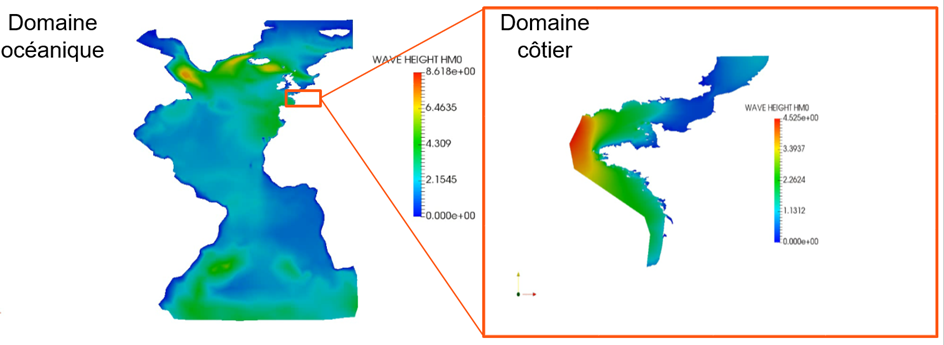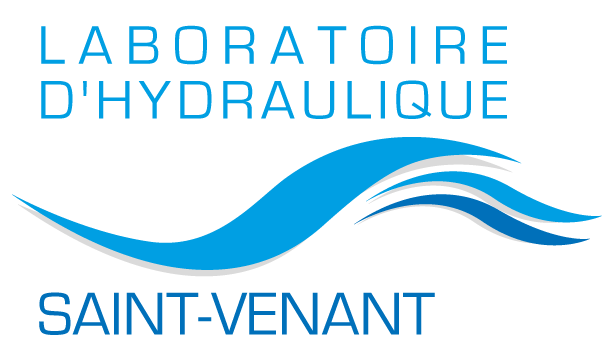Climatology and extremes of marine hazards along the coasts of Western Europe: characterization of present metocean conditions and possible evolutions under climate change scenarios.
Présentation
Durée : 24 months - deadline for application: April 30th, 2024
We are seeking to fill a 24-month post-doctoral position to work at the Saint-Venant Laboratory for Hydraulics (LHSV) in Chatou (Paris area, France) on the climatology and extremes of marine hazards (sea states and storm surges) along the coasts of Western Europe: characterization of present metocean conditions and possible evolutions under climate change scenarios. Details on the research project, hosting laboratory and conditions to apply are given below.
General context of the research project:
The understanding and characterization of the different risks related to submersion of coastal protections due to oceanic storms, the characterization of marine renewable energy resources or morphodynamical and erosion processes, are subjects of several studies at EDF R&D and LHSV. For this purpose, the knowledge and analysis of the current and extreme marine hazards climatology, namely sea states and sea levels (resulting mainly from the combined effects of tides and storm surges) is essential. Available measurements, from satellite or in-situ sensors, can be a useful source but they are seldom available over a long period of time and/or with a fine spatial resolution to study a particular area of interest. To overcome these difficulties, numerical hindcast wave and sea-level databases can be a valuable solution by providing complete time series of data over several decades and with a fine spatial resolution.
That is one of the reasons why EDF R&D and CEREMA developed various successive versions of the ANEMOC (Atlas Numérique des Etats de Mer Océaniques et Côtiers) wave numerical database covering different spatial regions of the World (e.g. China Sea, Mediterranean Sea, Reunion Island, French West Indies and Atlantic Ocean). ANEMOC is built with the third-generation spectral wave model TOMAWAC (Benoitet al., 1996), part of the open-source openTelemac numerical platform (open-source code, www.opentelemac.org), developed at EDF R&D, and it solves the wave action balance equation taking into account different source and sink terms. The latest version of ANEMOC within the Atlantic Ocean, called ANEMOC-3 (Raoult et al., 2018; Teleset al., 2022), incorporates the effect of tidal water levels and currents on wave propagation through the hydrodynamic circulation model TELEMAC-2D, also part of the openTelemac platform. ANEMOC3 presents two distinct spatial domains: one is the oceanic domain, covering the whole Atlantic Ocean, and the other is the coastal domain, covering the French coastal zones with a finer resolution (cf. figure 1). ANEMOC-3 covers the period 1979-2023, allowing to have a complete 45-year time series of wave parameters over the two computational grids. The numerical wave parameters were validated against satellite altimeter data and wave buoys measurements along the French coast during the series of strong storms that occurred in the winter 2013-2014, and that impacted severely the Atlantic French coastlines (Teles et al., 2022).
This version of 45-year hindcast database ANEMOC-3 will be the starting point and the basis of characterisation of the present climatology of sea-states and storm surges.

Figure 1 : Oceanic and coastal domains of ANEMOC-3 wave numerical database
The project will cover the study of possible future evolutions of the current climatology under various scenarios for climate change (CC) in order to refine our knowledge of these hazards by 2050 and 2100 typically (mean climate and extreme values). Research in this direction has already been done at EDF R&D LNHE and LHSV within the PhD of Amelie Laugel (2013), see also Laugel et al. (2014), using two different downscaling methods. This question is of the utmost interest for EDF, who has undertaken a dedicated project, called ADAPT, to anticipate the effects associated with CC and prepare adaptation measures or management plans to cope with these possible evolutions. The present research project fits within the research projects R-ADAPT and MOISE of EDF R&D.
Subject and objectives of the post-doctoral research
The target program will encompass both the present and future climatology of marine hazards, focusing on the Western part of the European waters, in particular the coastal regions of France and UK (Atlantic Ocean, English Channel and North Sea). The research will start with a literature survey on the questions of interest, covering existing studies based on field measurements, numerical simulations, impact of CC on waves and storm surges climatology, etc.
A. Present metocean conditions:
The comparisons made up to now between the calculated wave numerical parameters from ANEMOC-3 against satellite and in-situ measurements show a good agreement regarding the current (average) sea states. Statistical analyses of the present climatology of these hazards will be performed, covering both mean and extreme conditions, with particular attention paid to (1) the statistics of extreme values, and (2) identification of evolution trends of the mean and extreme values of the hazards over the last four decades, in relation with global climate indices, such as the North Atlantic Oscillation (NAO) index, for instance.
B. Future metocean conditions under climate change (CC) scenarios:
As already mentioned, within the ADAPT project, EDF group is working on possible CC impacts around the French inland and overseas territories. Different studies were carried out in the last years, in particular regarding marine hazards at EDF and LHSV (Laugel, 2013; Laugelet al., 2014). In the latter work, the future wave climate has been simulated over the period 2061-2100 using both dynamical and statistical downscaling methods. In particular, an original approach comparing sea-state projections obtained from dynamical and statistical downscaling methods has been applied over the period 2061-2100 for B1, A1B and A2 scenarios (from the Fourth Assessments Reports, IPCC, 2007), based on the ARPEGE-CLIMAT model simulations. Wave spectral parameters resulting from the projections (i.e. significant wave height, mean period, mean direction and wave energy flux) have been compared in terms of mean, joint distribution and seasonal and interannual variability. The possible CC impacts on the wave climate along the Atlantic, English Channel and North Sea French coastline have also been evaluated. The analysis provided estimates of the inherent uncertainties of climate change scenarios and downscaling methods.
In the present project, we will build on this existing knowledge and methods, incorporating recent progress in methodologies and modelling techniques, and considering up-to-date predictions from Global Climate Models (GCM) as input data (wind and surface pressure fields) to drive our wave and hydrodynamic models. The estimation of CC impacts on marine hazards requires three key parameters: (i) detailed knowledge of current wave climate variability (established by objective A of the present work), (ii) the application of CC scenarios from GCM and (iii) the definition and use of an appropriate downscaling method. Various CC scenarios will be considered, and several GCM models will have to be considered to assess the uncertainties associated with GCM models. This research will build on existing efforts and initiatives in this field, such as COWCLIP for instance (https://cowclip.org/), and will also take benefit of the most recent developments and results, e.g. Liu et al. (2023), Meucci et al. (2024), just to mention two examples.
The outcome of this part of the work will be a refined knowledge of future (i.e. by 2050 and 2100) climatology of marine hazards in the Western European waters, considering once again both the mean (usual) conditions (including seasonal and interannual variability) and the extremes values, and associated uncertainties.
References:
- Benoit M., Marcos F., Becq F. (1996) Development of a third-generation shallow water wave model with unstructured spatial meshing. Proc. 25th Int. Conf. on Coastal Eng. (ICCE'1996), 2-6 September 1996, Orlando (Florida, USA), pp 465-478.
- Laugel A. (2013) Climatologie des états de mer en Atlantique nord-est : analyse du climat actuel et des évolutions futures sous scénarios de changement climatique, par descente d'échelle dynamique et statistique. PhD thesis from Université Paris-Est, Paris (France), prepared at the Saint-Venant Hydraulics Laboratory and defended on 11/12/2013.
- Laugel A., Menendez M., Benoit M., Mattarolo G., Mendez F. (2014) Wave climate projections along the French coastline: dynamical versus statistical downscaling methods. Ocean Modelling, 84, 35–50. DOI: 10.1016/j.ocemod.2014.09.002
- Liu Q., Young I.R., Zieger S., Ribal A., Long S.-M., Dong X., Song Z., Guan C., Babanin A.V. (2023) On global wave height climatology and trends from multiplatform altimeter measurements and wave hindcast. Ocean Modelling, 186, 102264. DOI: 10.1016/j.ocemod.2023.102264.
- Meucci A., Young I.R., Trenham C., Hemer M. (2024) An 8-model ensemble of CMIP6-derived ocean surface wave climate. Scientific Data, 11, 100. DOI: 10.1038/s41597-024-02932-x
- Raoult C., Joly A., Andreevsky M., Jolly-Laugel A. (2018) ANEMOC-3: Improving the ANEMOC-2 Sea state database by adding tide effects. In Actes des 16èmes Journées de l’Hydrodynamique, 27-29 Novembre 2018, Marseille (France).
- Teles M., Weiss M., Benoit M. (2022) Assessment of the ANEMOC-3 sea state hindcast database for modelling a series of energetic winter storms along the French coast. Proc. XVIIèmes Journées Nationales Génie Côtier Génie Civil, 11-13 Octobre 2022, Chatou (France), pp 171-182. DOI:10.5150/jngcgc.2022.019
About Saint-Venant laboratory (LHSV) and the hosting research team:
The Saint-Venant Laboratory for Hydraulics (LHSV) is a joint research unit between Ecole des Ponts (ENPC), one of the top-level engineering schools in France, and the R&D division of Electricité de France (EDF R&D), Dept. Laboratoire National d’Hydraulique et Environnement (LNHE). The laboratory has a unique position in the field of applied fluid mechanics for free surface flows in inland waters, rivers, estuaries, coastal zones and oceans, at the interface between academy and industry.
The laboratory has access to a variety of facilities, such as 8000 m2 of experimental facilities and high-performance Computational Fluid Dynamics models for flow and transport processes, including the open-source openTelemac modelling system (http://www.opentelemac.org). The laboratory is located on the EDF Lab site in Chatou (France), about 12 km from Paris downtown (address: 6 quai watier, 78400 Chatou, France). It can be easily reached by the public transportation network of Paris area (subway-RER line A – station “Rueil-Malmaison”).
More information about the laboratory can be found at: http://www.saint-venant-lab.fr
Who can apply:
Successful applicants should, by the start of the appointment, have a Ph.D., or equivalent experience in free surface hydrodynamics, coastal oceanography, wave and sea flow modelling, computer sciences and data analysis. First experiences in numerical modelling of waves, tides, and storm surges at global or regional scales, statistical analyses of large database of marine hazards, extreme value analysis, and downscaling methods are highly desirable.
The researcher will be employed by Ecole des Ponts (ENPC), with a 24-month contract (nominal weekly working rate of 35 hours). Salary and benefits will be commensurate with qualifications and experience.
Contacts
How to apply:
Applicants should send a cover letter and CV to Pr. Michel Benoit, who will be the main supervisor of this work together with Dr. Maria Teles and Dr. Marissa Yates:
- Pr. Michel Benoit [EDF R&D LNHE & LHSV], e-mail: michel.benoit@edf.fr
- Dr. Maria Teles [EDF R&D LNHE], e-mail: maria.teles@edf.fr
- Dr. Marissa Yates [ENPC & LHSV], e-mail: marissa.yates@enpc.fr
The deadline for application is April 30th, 2024.
The targeted starting date of the post-doctoral contract is September 1st, 2024.
Ce poste vous intéresse ?
Postulez en remplissant le formulaire ci-dessous.
Important : pour faciliter leur traitement, nous n'acceptons que les candidatures électroniques.
Pour candidater, merci de remplir le formulaire ci-dessous.
Toutes les informations fournies par vous resteront confidentielles et ne seront ni divulguées ni mises à disposition d’un autre organisme sans accord préalable écrit de votre part. Selon la loi informatique et libertés, vous disposez d’un droit d’accès et de rectification aux données vous concernant.

Mentions légales / Politique de confidentialitéX
